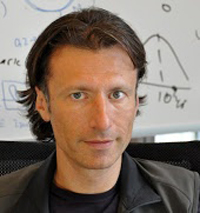Research overview
Research group: Theory of Elementary Particles, Astroparticle Physics, and Phenomenology (TEPAPP)
Neutrino physics and astrophysics
Recent discovery by the IceCube observatory of astrophysical neutrinos with PeV energies opens a new window on the universe. The origin of these neutrinos is still unclear. For example, distant blazars were expected to produce a spectrum peaked at 1 PeV. However, these neutrinos could also come from decays of dark matter particles.
Articles: Los Angeles Times; Scientific American, "Through Neutrino Eyes Ghostly Particles Become Astronomical Tools," G. Gelmini, A. Kusenko, T. Weiler; research papers about PeV neutrinos produced by blazars [PRL (2010), PRL (2013)]; and by dark matter [PRD 2013].
Primordial black holes could form in the early universe and could play an important role in generation of elements heavier than iron, the origin of which is a long-standing mystery.
Read a research paper on formation of primordial black holes in Phys. Rev. Lett. (2017).
Heavy elements, such as gold, platinum, uranium, could only form in an environment rich with neutrons. Stellar explosions do not provide the right conditions, and the mergers of neutron stars do not happen often enough (as confirmed by LIGO gravitational waves observations). However, if a small primordial black hole invades a neutron star, it can eat the star from the inside and eventually destroy it, ejecting some amount of neutron-rich nuclear matter. This process can explain the entire population of heavy elements in our galaxy, as well as the paucity of neutron stars in the galactic center, and it also explains why dwarf galaxies have a very uneven distribution of such elements. Furthermore, the emitted positrons can explain the origin of the observed 511-keV line from the galactic center.
Read a research paper (PRL Editor's Suggestion) about primordial black holes and r-process nucleosynthesis: Phys. Rev. Lett. (2017) and a Viewpoint article about this paper.
Dark matter: Most of the matter in the universe is dark matter, which is not made of ordinary atoms. The identity of dark matter particles remains a puzzle. A number of well-motivated dark-matter candidates have been considered. For example, if supersymmetry exists, than the lightest supersymmetric particle, or gravitino, or supersymmetric Q-balls can make up the dark matter. Another well-motivated candidate for such a particle is the right-handed or sterile neutrino. This idea is supported by compelling theoretical arguments and by intriguing astrophysical hints. The first dedicated search for dark matter using X-ray telescopes is under way [read research papers or a review article in Physics Reports].
Read about sterile neutrinos, dark matter, and the pulsar kicks: Scientific American (2011), Nature (2010), Scientific American (2010), Nature (2006), The Economist (2006), New Scientist (2006), CERN Courier (2006), New Scientist (1996).
Cosmic connections: from cosmic rays to gamma rays, to cosmic backgrounds and intergalactic magnetic fields. Supermassive black holes in the centers of distant galaxies can swallow large amounts of gas and stellar matter. Part of the energy is released in the form of a powerful jet which emits high-energy cosmic rays and gamma rays. The highest energy gamma rays cannot travel very far because they lose energy in interactions with starlight and infrared light re-emitted by dust. Yet, some very energetic gamma rays have been observed from some very distant objects. This created a puzzle, whose resolution pointed to a possible contributions of cosmic rays. Now there is a growing evidence that gamma rays arriving from distant sources (z>0.15) did not originate at the source, but were produced in the cosmic ray interactions along the line of sight. This surprising connection between cosmic rays and gamma rays resolves several puzzles, proves that cosmic rays of the highest energies are, indeed, produced in active galactic nuclei, and it opens some new ways to measure extragalactic background light, as well as intergalactic magnetic fields, which permeate deep space between galaxies, possibly, since the time of the Big Bang.
Read research papers in ApJ, ApJ Letters, AP, and Phys. Rev. Lett.
Read an article in Science (2010), and also in UCLA News.
Ultrahigh-energy cosmic rays present a number of puzzles. It is difficult to understand why a single cosmic particle should carry as much energy as a bullet! Moreover, recent results from Pierre Auger Observatory indicate that many of these particles are nuclei, not protons. This implies that natural nuclear accelerators, such as Gamma Ray Bursts and other unusual stellar explosions, have taken place in our own Galaxy in the past.
Read a research paper in Phys. Rev. Lett.
Read about cosmic accelerators in UCLA News or in CERN Courier (2010), and about Inexplicable nuclei in Nature (2010).
Supersymmetric Q-balls are non-topological solitons that owe their stability to a conservation of some global charge. Baryonic Q-balls appear in every supersymmetric extension of the Standard Model. If supersymmetry exists, stable Q-balls could be copiously produced at the end of inflation and may now exist as a form of dark matter [read a research paper or a review article in Rev. Mod. Phys.].
Baryogenesis: although every particle has its antiparticle, there is no antimatter in the observed universe. The process in which the matter-antimatter asymmetry was produced in the early universe, called baryogenesis, remains a mystery. An appealing scenario is the Affleck-Dine baryogenesis, which can generate both ordinary matter and dark matter [read a review article in Rev. Mod. Phys.].
This research is supported by the DOE Office of Science (High Energy Physics).

